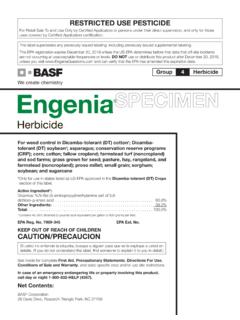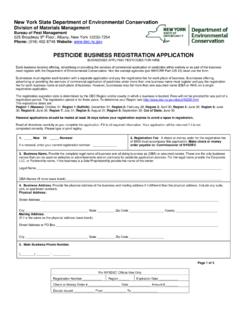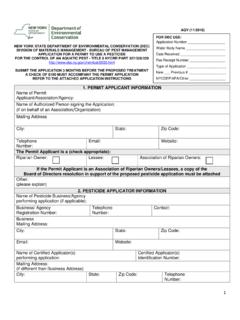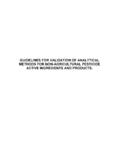Transcription of International Code of Conduct on the Distribution …
1 International Code of Conduct on the Distribution and Use of pesticides guidelines on compliance and enforcement of a Pesticide Regulatory Programme FOOD AND AGRICULTURE ORGANIZATION. OF THE UNITED NATIONS. JUNE 2006. This publication was developed in the IOMC context. The contents do not necessarily reflect the views or stated policies of individual IOMC Participating Organizations. The Inter-Organisation Programme for the Sound Management of Chemicals (IOMC) was established in 1995 following recommendations made by the 1992 UN Conference on Environment and Development to strengthen co-operation and increase International co-ordination in the field of chemical safety. The participating organisations are FAO, ILO, OECD, UNEP, UNIDO, UNITAR and WHO. The World Bank and UNDP are observers.
2 The purpose of the IOMC is to promote co- ordination of the policies and activities pursued by the Participating Organisations, jointly or separately, to achieve the sound management of chemicals in relation to human health and the environment. The designations employed and the presentation of material in this information product do not imply the expression of any opinion whatsoever on the part of the Food and Agriculture Organization of the United Nations (FAO) concerning the legal or development status of any country, territory, city or area or of its authorities, or concerning the delimitation of its frontiers or boundaries. The mention of specific companies or products of manufacturers, whether or not these have been patented, does not imply that these have been endorsed or recommended by FAO in preference to others of a similar nature that are not mentioned.
3 The views expressed in this information product are those of the author(s) and do not necessarily reflect the views of FAO. All rights reserved. FAO encourages the reproduction and dissemination of material in this information product. Non-commercial uses will be authorized free of charge, upon request. Reproduction for resale or other commercial purposes, including educational purposes, may incur fees. Applications for permission to reproduce or disseminate FAO copyright materials, and all queries concerning rights and licences, should be addressed by e-mail to or to the Chief, Publishing Policy and Support Branch, Office of Knowledge Exchange, Research and Extension, FAO, Viale delle Terme di Caracalla, 00153 Rome, Italy. FAO 2006. Table of contents DEFINITIONS.
4 5. 1. INTRODUCTION .. 8. 2. CORE PRINCIPLES OF compliance AND enforcement .. 10. The goal is immediate, full, and continuous compliance .. 10. An overall culture of compliance is critical to achieving compliance 11. compliance goals are most achievable if requirements are clear, widely known and understood .. 11. Regulated entities should see self correcting activities as preferable to government 11. There should be a reasonable likelihood that violations will be detected by or brought to the attention of government .. 12. Governmental response to violations should be fair, predictable and proportional 12. There should be a level playing field no comparative economic advantage to non- compliance .. 12. Governments must send messages that will encourage deterrence, including publicity on violations.
5 12. Public and private regulated entities should have to play by the same rules with similar consequences for 13. Government should be transparent (consistent with law enforcement needs or confidentiality and with rights of private parties) and accountable .. 13. 3. DESIGNING AND BUILDING THE compliance AND enforcement PROGRAMME .. 14. Clarifying roles and responsibilities .. 14. Sources of funding and 15. Common expertise, policies, and activities .. 15. Centralization/decentralization .. 16. Sample national implementation (Countries A,B,C) .. 17. Creating enforceable requirements .. 18. Necessary elements for 18. Sample national implementation (Countries A,C,D) .. 18. Knowing and understanding regulated entities .. 19. Steps for understanding the regulated community.
6 19. Sample national implementation (Countries A,B,D) .. 20. Planning and setting 21. Elements of planning and priority setting .. 21.. 23. Sample national implementation (Countries A,B,C,D) .. 23. Promoting and encouraging 24. The role of compliance promotion .. 24. Sample national implementation (Countries A,B,D) .. 25. Monitoring 26. Aspects of compliance monitoring .. 26. Sample national implementation (Countries A,C) .. 26. Responding to violations .. 27. After detection, designing the governmental response .. 27. Sample national implementation (Countries A,B,C,D) .. 28. Evaluating programme 29. The importance of evaluation, measurement and accountability .. 29. Sample national implementation (Countries A,B,C,D) .. 30. 4. 32. 3. ANNEX A .. 33. LEGAL TOOLS AND INSTRUMENTS.
7 33. Clear, mandatory, monitorable requirements .. 33. Defined illegal acts .. 34. Inspection, investigatory, and monitoring authorities .. 35. Legal authority to address emergencies, mandate compliance , impose monetary penalties, impose criminal 37. ANNEX B .. 42. DEVELOPING enforcement CAPACITY INSTITUTIONS .. 42. Agenc(ies) .. 42. 43. Equipment/laboratories/etc .. 45. Scientific/legal/administrative expertise .. 46. Independence/Professionalism/Integrity .. 47. 47. 4. Definitions For the purposes of these guidelines : Administrative action means an enforcement response such as a sanction or an order that can be issued directly by the administrative authority without the initial involvement of the judiciary. Civil judicial action means an enforcement response such as a sanction or an order that is obtained through the civil court system.
8 compliance means the full implementation of legal requirements. compliance incentives means specific rewards or benefits provided in exchange for compliance , especially for voluntary compliance before detections of any violations by government. compliance monitoring means collecting and analyzing information on compliance status of an entity or facility or of an industry or economic sector. compliance promotion means any activity that encourages voluntary compliance with requirements. Examples of compliance promotion include educational programmes and technical assistance. Civil enforcement means investigation and legal actions to compel compliance and/or impose sanctions that involve the civil (non-criminal) legal system. Criminal enforcement means investigation and legal actions to compel compliance and/or impose sanctions that involve the criminal justice system.
9 Deterrence means an atmosphere in which people are discouraged from violating requirements and motivated to choose to comply in order to avoid adverse consequences. Disposal means any operation to recycle, neutralize, destruct, isolate or abandon pesticide waste, used containers and contaminated materials. Distribution means the process by which pesticides are supplied through trade channels to local or International markets. Enforceable means able to be enforced. enforcement means the set of actions that governments or others take to achieve compliance by the regulated community with pesticide regulatory requirements and /or to halt situations that may endanger public health of the environment. Government enforcement usually includes activities like investigations, negotiations and legal actions.
10 Environment means surroundings, including water, air, soil, and their interrelationship as well as all relationships between them and any living organisms. Establishment see facility. Facility means any place or operation where pesticides are manufactured, held, stored, marketed, sold, distributed, transported, used or disposed or where records relating to such activities are maintained. 5. Fine see monetary penalty. Inspection means official review and examination of the compliance status of a facility. Judicial enforcement means legal enforcement actions involving the courts and the judiciary. Label and labeling mean the written, printed or graphic matter on, or attached to, the pesticide or the immediate container thereof and also to the outside container or wrapper of the retail package of the pesticide.
















